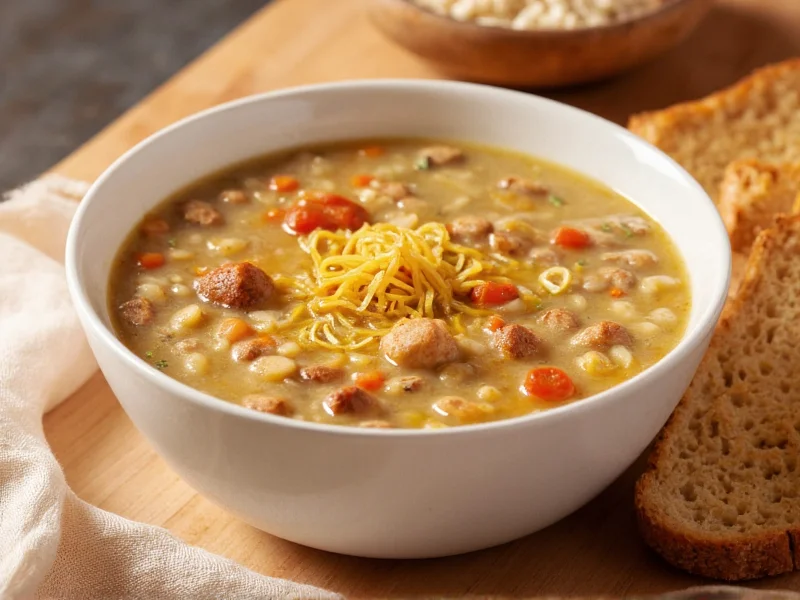When you pour milk over your morning cereal, are you actually eating soup? This question has sparked debates across dinner tables and internet forums. The straightforward answer based on culinary definitions is no—cereal doesn't qualify as soup. Let's examine why this classification matters and what truly distinguishes these two food categories.
Defining Soup: What Makes Soup Soup?
Soup has specific culinary characteristics that define it as a distinct food category. According to food science and culinary tradition, soup must meet several criteria:
- Cooked preparation—Soup requires simmering ingredients in liquid
- Broth or stock base—Water alone doesn't make soup; it needs flavorful liquid foundation
- Ingredient integration—Components blend together through cooking
- Temperature—Traditionally served hot (though chilled soups exist)
Cereal fails to meet every one of these fundamental requirements. The grains in cereal are pre-cooked during manufacturing but the final preparation involves no cooking step. You simply add cold milk to ready-to-eat grains.
Cereal vs. Soup: A Structural Comparison
| Characteristic | Soup | Cereal |
|---|---|---|
| Preparation Method | Cooked (simmered/broiled) | No cooking required |
| Liquid Base | Broth, stock, or consommé | Cold milk or plant-based alternatives |
| Temperature | Typically hot | Served cold |
| Ingredient Integration | Flavors meld during cooking | Components remain distinct |
| Historical Classification | Recognized food category for millennia | Modern breakfast innovation |
The Milk Misconception
Many people argue that since both soup and cereal contain liquid with solid pieces, they're fundamentally similar. This cereal vs soup classification argument overlooks critical distinctions. The milk in cereal doesn't transform the dish into soup for several reasons:
- Milk serves as a cold accompaniment rather than a cooking medium
- No flavor transfer occurs between cereal and milk (unlike soup ingredients)
- Cereal components maintain their structural integrity
- The liquid doesn't become infused with flavors from the solid components
Consider this: if pouring liquid over food made it soup, then yogurt with fruit, iced tea with lemon, or even coffee with cream would all qualify as soup—which clearly isn't the case.
Culinary Expert Perspectives
Professional chefs and food scientists consistently classify cereal outside the soup category. Dr. Helen Feast, food historian at Culinary Institute of America, explains: "Soup requires the transformative process of cooking to create a unified dish where flavors integrate. Cereal's preparation lacks this essential culinary process. The milk merely moistens the cereal—it doesn't cook it or create new flavor compounds through heat application."
This perspective aligns with how culinary institutions categorize foods. The Larousse Gastronomique, considered the encyclopedia of French cuisine, lists hundreds of soup varieties but makes no mention of cereal in this category.
Why This Debate Matters
The is breakfast cereal considered soup question might seem trivial, but it touches on important concepts in food science and cultural classification. Understanding food categories helps with:
- Nutritional analysis and dietary planning
- Culinary education and technique development
- Food regulation and labeling requirements
- Cultural understanding of meal structures
Misclassifying foods can lead to confusion in dietary guidelines, recipe development, and even food safety protocols. Soup requires specific handling procedures due to its liquid nature and cooking process that don't apply to dry cereal products.
Historical Context: How Cereal and Soup Evolved Separately
Soup has ancient origins, with evidence of soup-like preparations dating back 20,000 years. Early humans discovered that boiling food in water made it more digestible and flavorful. Cereal, by contrast, is a relatively modern invention—breakfast cereal as we know it emerged in the late 19th century as a health food movement product.
Their historical development paths never converged. Soup evolved as a method of food preparation, while cereal developed as a convenient, ready-to-eat breakfast option. This historical separation reinforces their distinct culinary identities.
Common Misconceptions About Cereal as Soup
Several arguments mistakenly suggest cereal qualifies as soup:
- The "liquid with solids" argument—Ignoring that preparation method defines food categories
- The "oatmeal is cereal and soup" confusion—Oatmeal is cooked porridge, not ready-to-eat cereal
- The "soup can be cold" point—Missing that temperature alone doesn't define soup
These food category debate cereal soup misunderstandings stem from oversimplifying culinary classification. Food categories consider multiple factors beyond just physical composition.
The Verdict: Why Cereal Isn't Soup
After examining culinary definitions, preparation methods, historical context, and expert opinions, the conclusion remains clear: cereal doesn't meet the criteria for soup classification. The why cereal isn't soup explanation centers on three irrefutable points:
- Cereal requires no cooking in its final preparation stage
- Milk serves as a cold accompaniment rather than a cooking medium
- No flavor integration occurs between components
While both involve liquid and solid elements, this superficial similarity doesn't override their fundamental differences in preparation, composition, and culinary purpose. Calling cereal soup would be like calling a sandwich a stew—both contain ingredients, but the preparation method creates entirely different food experiences.











 浙公网安备
33010002000092号
浙公网安备
33010002000092号 浙B2-20120091-4
浙B2-20120091-4